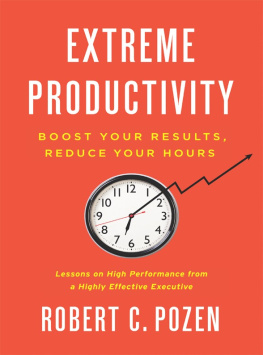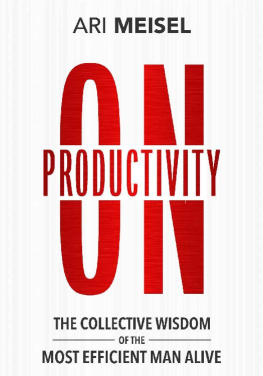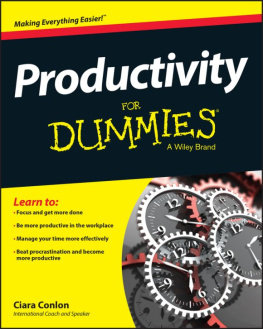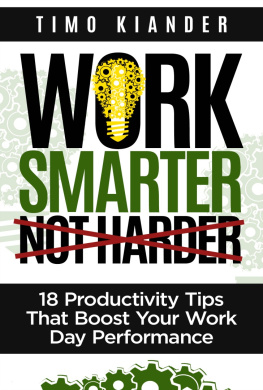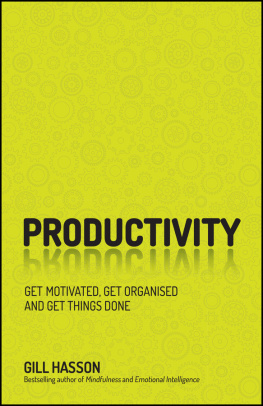
To my children, Joanna and David, who have given me so much love and support
CONTENTS
P eople often ask me how I get so much done. During most of the last five years, Ive held two full-time jobsserving as full-time chairman of MFS Investment Management and carrying a full teaching load at Harvard Business School. Ive also served on the governing boards of two publicly traded companies (Medtronic and Nielsen), a health care foundation (the Commonwealth Fund), and a medical research center (the Harvard NeuroDiscovery Center). At the same time, Ive managed to write three books (including this one) and publish roughly a hundred articles in newspapers and magazines. Through all this, Ive maintained a strong relationship with my wife of thirty-five years and our two children, as well as a wide network of friends and relatives.
Though these multiple roles did not seem unusual to me, the editors of the Harvard Business Review (HBR) were intrigued and asked if they could interview me about the secret recipe for my productivity sauce. When these interviews elicited a large positive response in the blogosphere, the HBR editors asked me to write a short article distilling my principles of productivity. I got even more enthusiastic reactions to that article. Strangers stopped me in airports to talk about productivity, and an MIT professor thanked me for improving his reading habits.
However, because the article only skimmed the surface of what can be said about personal productivity, I decided to write this book. In reflecting upon productivity over my career, I can point to a number of habits and methods that have helped me become successful. But even more critical was the realization early in my career that success comes not just from hard work and careful planningthough those are both important. Success depends in large part on a proper mind-set: focusing on the results you plan to achieve, rather than the number of hours you work. The results are what matter most to your employer, clients, and colleagues.
WHAT IS PERSONAL PRODUCTIVITY?
Lets begin with what I mean by personal productivity. I mean the quantity and quality of your results in achieving your own objectives. I wont attempt to dictate what those objectives should be, only that you should clearly articulate them and their relative priority. You may be looking to climb the corporate ladder as quickly as possible or seeking a better balance between your professional and personal lives. In either case, you will benefit by getting more done in the hours you work.
This book does not ask you to embrace a new philosophy of life in order to be successful. It does not even require you to adopt a totally integrated system for personal productivity. It contains specific and practical suggestions on how to increase your productivity at work. You can pick and choose whichever suggested techniques seem most helpful to you.
The suggestions in this book are much broader than those in the typical manual on time management, with its emphasis on mundane tasks such as organizing your files. Although time management is a significant component of productivity, it is not the only one. A useful set of recommendations on productivity should cover a wider range of topics, as this book doesfor example, on setting goals for your career and developing skills such as effective writing.
Most fundamentally, the book urges you to adopt a different mind-set as well as to follow concrete techniques. As I previously noted, in order to be productive, you have to focus on the results you want to achieve, not the time you spend at work. Unfortunately, this mind-set is directly at odds with the system of billable hours in accounting or law firms and the emphasis on hours logged at the office in most occupations.
Last, this book is not selling snake oil. In the 1830s, some authors suggested that one could succeed only by following a special diet, sleeping on a hard bed, or abstaining from masturbation! More recently, others have urged quick fixes like holding many short meetings or working only a few hours per week. There are no miracle cures in this book. Most of my recommendations call for rigorous thinking and disciplined behavior sustained over long time periods.
SPECIFIC AND PRACTICAL ADVICE
This book is organized into five main parts, each with two or three chapters. The end of each chapter includes specific and practical takeawayslessons to be learned.
Part I tells you the three big ideas underlying the rest of the booksetting goals with explicit priorities, focusing on the final results, and not sweating the small stuff.
Part II helps you implement your short-term priorities in a disciplined manner. It contains chapters on organizing your daily routine, managing your travel schedule, and running efficient meetings.
Part III helps you develop three key personal skills that are critical to becoming a successful professional. It contains chapters on improving your reading comprehension, writing abilities, and effectiveness in public speaking.
Part IV helps you navigate through the organizational challenges of personal productivity. It contains chapters on managing down by delegating functions and managing up by working well with your boss.
Part V provides you with a framework for making long-term decisions about your career. It contains chapters on maximizing your options, succeeding in a rapidly changing world, and achieving a satisfying work-life balance.
THE KNOWLEDGE WORKERS GUIDE TO PRODUCTIVITY
Ive written this book for all types of professionalsthose who primarily use their brains in their work. This includes accountants, computer programmers, doctors, engineers, investment bankers, lawyers, marketers, psychologists, real estate brokers, retailers, scientists, teachers, and so on. Although the majority of the books examples are drawn from the commercial world, most of its lessons apply to professionals in other types of organizations: not-for-profit institutions, academia, and government. No matter where you work, you probably face many of the same challenges in allocating your time, running meetings, and dealing with difficult bureaucracies.
Though each of the books five parts addresses all professionals, some chapters are particularly relevant to groups at certain stages of their careers. Those beginning their professional career may be particularly interested in the chapters on career planning and business writing. Those climbing the corporate ladder may be particularly interested in the chapters on managing up and down. Senior executives may be particularly interested in the chapters on efficient travel and effective speeches. To get the most out of this book, concentrate on the sections that are most relevant to you.
MY PATH TO PRODUCTIVITY: HOW I LEARNED TO BE PRODUCTIVE
Before we get into the first part of this book, I want to share with you my own history of learning how to be productive. Unlike many productivity gurus, I have not been a consultant on the subject; Ive developed my productivity techniques by working in various types of organizations and at various levels. Later in my career, when I was the boss, I could draw upon the resources of a large organization. But early in my career, I worked alone or with peers, and sometimes had to deal with difficult bosses.
I was raised in a family with a high degree of discipline and organization. My father dropped out of high school and worked as a traveling salesman for mens underwear and shirts. The highlight of his career was his stint as an army officer during World War II. After a week on the road as a traveling salesman, he would carefully inspect our house to ensure that everything was in its proper place, harkening back to his old days in the army.
Next page


